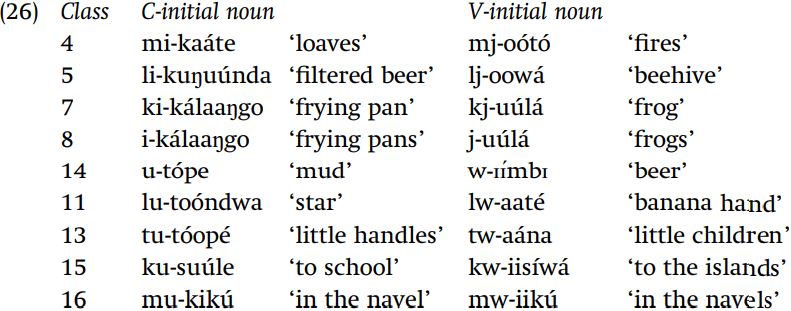


 Grammar
Grammar
 Tenses
Tenses
 Present
Present
 Past
Past
 Future
Future
 Parts Of Speech
Parts Of Speech
 Nouns
Nouns
 Verbs
Verbs
 Adverbs
Adverbs
 Adjectives
Adjectives
 Pronouns
Pronouns
 Pre Position
Pre Position
 Preposition by function
Preposition by function 
 Preposition by construction
Preposition by construction
 Conjunctions
Conjunctions
 Interjections
Interjections
 Grammar Rules
Grammar Rules
 Linguistics
Linguistics
 Semantics
Semantics
 Pragmatics
Pragmatics
 Reading Comprehension
Reading Comprehension|
Read More
Date: 2024-04-16
Date: 2024-05-11
Date: 2024-02-21
|
The following data from Matuumbi illustrate the different surface realizations of the noun-class prefixes (nouns are assigned lexically or syntactically to different classes, conventionally numbered between 1 and 21). You should be able to discern and formalize the rule that applies in these data, and order those rules correctly. What rule applies in the following data?

The examples in (27) illustrate three rules. First, there is an optional rule applying in both subsets of (27) which deletes u after m, hence in these words, the prefix /mu/ can be pronounced in two ways, one with u and one without u. You should formalize the optional vowel deletion rule illustrated by these data.
An independent rule assimilates a nasal to the place of articulation of the following consonant (we saw this rule in previous Matuumbi data). This rule applies in both subsets of examples, and is the only other rule besides deletion of u involved in the first subset. The third rule applies in the second subset of examples, and explains the change in the initial consonant of the stem. This rule only applies to a glide preceded by a nasal which is separated by a morpheme boundary, notated in rules as “+.”

(An alternative transcription of these second set of forms would be ŋŋwesa and so on: the point of writing this as [ŋŋwesa] is to make clear that there is a change in the nature of the initial segment, and not the addition of another segment.)
The examples in (28) illustrate the point that nouns in class 7 in the singular (marked with the prefix ki-) have their plural in class 8 (with the prefix i-). The plural locative form gives further illustration of a phonological rule of the language which we already know.

How do you explain the following examples of nouns, which also have singulars in class 7 and plurals in class 8, given that the class prefixes in these examples are underlyingly /ki-/ and /i-/?

The data in (29) demonstrate a specific conclusion about the ordering of two of the rules motivated here: what is that conclusion?
|
|
|
|
لخفض ضغط الدم.. دراسة تحدد "تمارين مهمة"
|
|
|
|
|
|
|
طال انتظارها.. ميزة جديدة من "واتساب" تعزز الخصوصية
|
|
|
|
|
|
|
مشاتل الكفيل تزيّن مجمّع أبي الفضل العبّاس (عليه السلام) بالورد استعدادًا لحفل التخرج المركزي
|
|
|